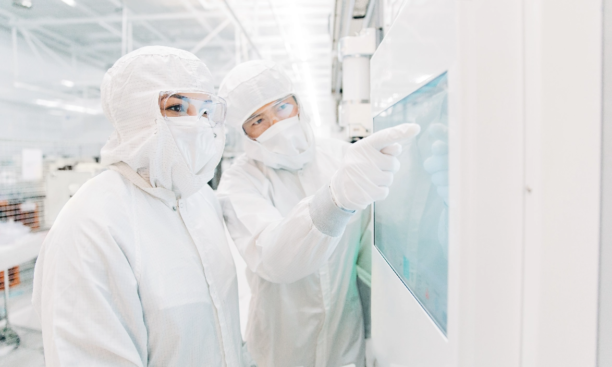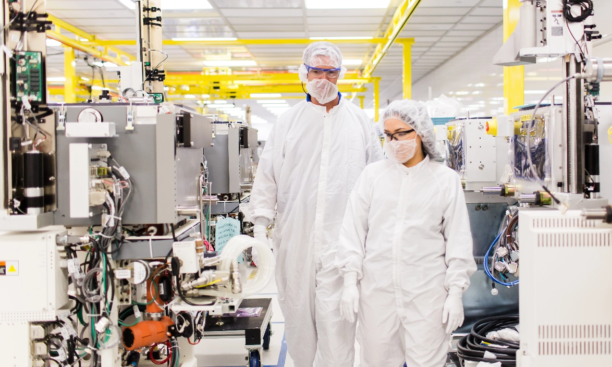We aspire to incorporate environmental sustainability into everything we do.
Let's prove it.
At Lam, we seek to contribute to a better world. And as the need to address climate change and slow global warming grows increasingly urgent, we are acting with purpose.
Across our organization, we are taking ownership and accountability to reduce carbon footprint and care for our planet. We’re working with our customers, suppliers, and employees to get there. Together, we’re thinking big and moving toward net zero.
Our path to net zero
Establish the vision. Do the work. That’s how we’re bringing our net zero ambition into sight. Our approach to progress includes:
Goals
Net zero is a climate action goal to balance the amount of greenhouse gases (GHGs) being released into the atmosphere with the amount of GHGs being removed. Lam has joined organizations worldwide that are setting net zero goals so that, collectively, we seek to limit global warming to 1.5 degrees Celsius.
Announced Science-Based Target initiative (SBTi) intention and net zero pathway
Achieved SBTi approval for three near-term emissions reduction targets*
Reduce absolute Scope 1 and 2 (market-based) GHG emissions by 25% from a 2019 baseline
Achieve 12M kWh in total energy savings from a 2019 baseline
46.5% of suppliers and 83% of customers measured by emissions have science-based targets (SBTs)*
Reduce absolute Scope 1 and 2 (market-based) GHG emissions by 60.6% from a 2019 baseline*
Achieve 100% renewable electricity*
95% of top direct suppliers measured by spend have SBTs
Achieve net zero operations
(Scope 1 and 2)
Achieve absolute reduction in supply chain emissions (goal to be set)
Achieve net
zero emissions
* short-term GHG emission reduction targets approved by the SBTi
Our goals aim to cover various greenhouse gas emissions sources across all aspects of our business.
| UPSTREAM ACTIVITIES | Lam facilities and operations | DOWNSTREAM ACTIVITIES | |||||
|---|---|---|---|---|---|---|---|
| UPSTREAM ACTIVITIES |
Scope 3 indirectKey contributors:
How we’re moving the needle:Engaging suppliers to support them in setting SBTs and reducing their climate impacts |
Lam facilities and operations |
Scope 2 market-based indirectKey contributor:
How we’re moving the needle:Maximizing energy efficiency and investing in renewable electricity and renewable energy credits (RECs) |
Scope 1 directKey contributors:
How we’re moving the needle:Optimizing our processes, products, and facilities to make them more energy- and resource-efficient |
DOWNSTREAM ACTIVITIES |
Scope 3 indirectKey contributors:
How we’re moving the needle:Engaging customers and identifying opportunities to reduce energy and emissions associated with the use of our products |
|
Building the foundation
While our net zero goals are forward thinking, progress starts now. With our long-term roadmap in place, we’re building the foundation needed to achieve our goals. That means ramping up our resources, building teams and detailed plans, and focusing on three key areas of our business. Here’s a look at the actions we’re taking across our organization and supply chain.

Facilities
As we work to decarbonize our operations, we’re focused on enhancing energy efficiency, reducing water usage, and minimizing waste. We’re also investing in renewable electricity solutions, with solar arrays installed at several sites.

Suppliers
We collaborate with suppliers to reduce our supply chain-based emissions through ongoing engagement and data collection. Lam’s Supply Chain ESG team spearheads these efforts and has launched a supplier engagement platform to track suppliers’ climate-related goals and performance.

Customers and products
We are establishing baseline data for our products’ energy consumption and GHG emissions and engaging with customers to align on sustainability metrics and targets. This work informs our investments in R&D as we develop solutions that support our company and customers’ emissions-reduction goals.
Net zero starts with clear ownership
Achieving net zero emissions is a critically important initiative. It requires strong governance to deliver effective outcomes. With this in mind, oversight goes all the way up to our Board of Directors. We also have a Net Zero Leadership team and various working groups to support and monitor our ongoing progress.
To inspire broader action, we engage closely with Lam’s customers and suppliers and are active in industry organizations. We strive to lead by example, including by becoming the first U.S.-based semiconductor equipment manufacturer to receive SBTi approval for its near-term GHG emissions reduction goals. Lam is also a founding member of the Semiconductor Climate Consortium, the first global, ecosystem-wide collaborative of semiconductor companies dedicated to reducing GHG emissions. Through collaboration, transparency, and ambitious goal setting (in accordance with the best available science), the consortium aims to advance the semiconductor industry’s response to climate change—one of the most pressing challenges of our time.
Addressing the risks of climate change to unlock new opportunities
We take a proactive approach to risk management and our approach to climate change is no different. By identifying the risks that climate change poses, we can take meaningful steps to make our company more resilient. In 2021, we worked with a third party to complete an in-depth climate change risk analysis. Through the assessment, we also identified opportunities to unlock benefits for our stakeholders and business. The results of the analysis include:
 Risks
Risks
- Changing customer expectations
- Competitors developing lower-impact products
- Operational disruptions from flooding, natural hazards, rising temperatures, and/or water stress
- Natural hazards leading to supply chain disruptions and/or preventing access to the operational workplace
- Regulation of Lam’s direct operations, customer operations, and/or raw materials (e.g., carbon pricing)
- Reputational impacts from poor performance on external climate-related engagements
- Water stress impacting major customer operations
 Opportunities
Opportunities
- Expansion of end-use markets
- Improving resilience of business operations through asset hardening
- Operational footprint reduction
- Reduced resource consumption of sold products
As we learn more about the likelihood and potential effects of these risks, we seek to continue to share our management and mitigation efforts with stakeholders. To ensure best practices in making and reporting progress, we strive to align our efforts with leading ESG disclosure frameworks including the Sustainability Accounting Standards Board (SASB), the Global Reporting Index (GRI), and the Task Force on Climate-related Financial Disclosure (TCFD). Several of our practices align with the TCFD categories listed below:
| TCFD Category | Aligned Practices at LAM |
|---|---|
| TCFD Category: Metrics and targets | Aligned Practices at LAM: 2025 and 2030 GHG reduction goals aligned with Science Based Targets Initiative (SBTi) methodology
Scope 3 emissions inventory to understand impacts in the value chain 2050 goal to achieve net zero across all emissions scopes, with interim goals for 2030 and 2040 |
| TCFD Category: Risk management | Aligned Practices at LAM: Multiple leading enterprise risk management practices
Strong governance to manage and escalate risk to appropriate levels |
| TCFD Category: Strategy | Aligned Practices at LAM: Leadership involvement and oversight on ESG strategy |
| TCFD Category: Governance | Aligned Practices at LAM: Board-level ESG oversight
Regular ESG reports to the Board and the Nominating and Governance Committee Net zero leadership team and cross-functional working groups Annual net zero objectives integrated into corporate accountability systems and review |
| TCFD Category: Reporting | Aligned Practices at LAM: Consistent climate-related metrics reported to CDP and in our annual ESG Report |
Each year Lam reports environmental performance to CDP. In 2023 we received a B score from CDP on its Climate Change and Water Security surveys.
Download our Net Zero Emissions Infographic
The statements in this document are current as of June 2023. They include statements regarding our net zero initiative, strategy and goals that are forward-looking statements within the meaning of the Private Securities Litigation Reform Act of 1995. Forward-looking statements are subject to risks and uncertainties that could cause actual results to differ materially from the expectations expressed, including the risks and uncertainties described in the Risk Factors in our Form 10-K and 10-Q filings with the U.S. Securities and Exchange Commission. We undertake no obligation to update any forward-looking statements.

Investor Relations
Lam Research Corporation is a global supplier of innovative wafer fabrication equipment and services to the semiconductor industry.
Caution regarding forward-looking statements
Statements made on our Company webpage that are not of historical fact are forward-looking statements and are subject to the safe harbor provisions created by the Private Securities Litigation Reform Act of 1995. Such forward-looking statements relate to, but are not limited to: our goal to be net zero by 2050, our ESG strategy and related goals, our renewable electricity goals, our continued commitment to business integrity, the strength and effectiveness of our ethics and compliance framework, our environmental footprint, sustainability in our industry, our social impacts, our inclusion and diversity initiatives, and the sustainability of our products and operations. Some factors that may affect these forward-looking statements include: trade regulations, export controls, trade disputes, and other geopolitical tensions may inhibit our ability to sell our products; business, political and/or regulatory conditions in the consumer electronics industry, the semiconductor industry and the overall economy may deteriorate or change; the actions of our customers and competitors may be inconsistent with our expectations; supply chain cost increases and other inflationary pressures have impacted and may continue to impact our profitability; supply chain disruptions or manufacturing capacity constraints may limit our ability to manufacture and sell our products; and natural and human-caused disasters, disease outbreaks, war, terrorism, political or governmental unrest or instability, or other events beyond our control may impact our operations and revenue in affected areas; as well as the other risks and uncertainties that are described in the documents filed or furnished by us with the Securities and Exchange Commission, including specifically the Risk Factors described in our most recent annual report on Form 10-K and our quarterly report on Form 10-Q. These uncertainties and changes could materially affect the forward-looking statements and cause actual results to vary from expectations in a material way. The Company undertakes no obligation to update any forward-looking statements.